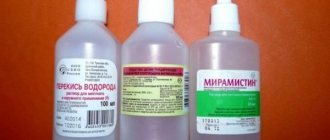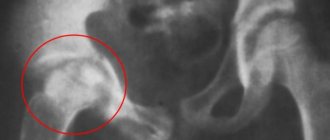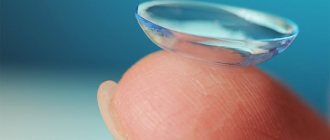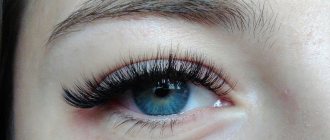What is hydrogen peroxide?
Peroxide is an aggressive chemical substance presented in the form of a colorless liquid without a pronounced odor. Due to its disinfectant and antiseptic properties, it is actively used for medicinal purposes.
Three percent peroxide (3%) is predominantly used to treat cuts and wounds. It accelerates the process of blood clotting and acts as an antiseptic. Moreover, unlike iodine and brilliant green, this substance does not cause acute discomfort. In some cases, hydrogen peroxide is used to irrigate the skin during thermal burns for disinfection.
The chemical formula of this product is quite simple - H2O2. When it enters the damaged skin, an oxygen release reaction occurs, which promotes the separation of purulent and blood clots, as well as dead areas of the epidermis. A three percent solution is also used to remove wax plugs in the ears. In addition, this remedy is used for various lesions of the oral cavity and inflammatory eye diseases for the purpose of disinfection. In this case, it is pre-diluted with water in order to reduce the concentration and avoid burns. In folk (alternative) medicine, there are different ways to use peroxide to treat infections, colds, foot fungus, etc.
It should be noted that peroxide is not only an antiseptic, but also a strong oxidizing agent.
This product is an active component of many cosmetics, including hair coloring. In addition, the substance is often present in household chemicals for removing stains, cleaning mirrors and kitchen appliances, as well as in peroxide solutions for the care of contact lenses. The scope of application of this substance is quite wide. Therefore, it is not so rare that cases of hydrogen peroxide getting into the eyes occur. Careless use of the solution can lead to very negative consequences, including corneal burns, as well as partial or complete loss of vision.
Areas of application of hydrogen peroxide:
- As an antiseptic for the disinfection of wounds and thermal burns (3% solution);
- To eliminate wax plugs in the ears (3% solution);
- For deodorizing and disinfecting the mucous membrane of the oral cavity, as well as the eyes for conjunctivitis (0.5% solution);
- For the treatment of infections, colds and foot fungus in folk medicine;
- As part of cosmetics (hair dye) and household chemicals;
- Contains peroxide solutions for cleaning contact lenses.
How to treat a runny nose with hydrogen peroxide
Before you begin treating a runny nose with hydrogen peroxide, it is necessary to establish the reasons that led to its occurrence. You can obtain the required information by visiting a qualified ENT doctor. In most cases, a runny nose is caused by:
According to the instructions for use, the pharmacological effect of the drug is an antiseptic antimicrobial effect, which requires small doses of solution to achieve. An increase in concentration can lead to swelling of the nasal mucous membranes and a deterioration in the general condition. It is recommended to use peroxide not as an independent remedy, but as a complex therapy. To treat a runny nose, you should buy a standard 3% solution.
Recommended video:
Treatment in adults
To treat a runny nose in adults, peroxide is used in the form of nasal drops in a ratio of 1:11 with cool boiled water. You can instill a couple of drops of the solution into each of the nasal passages. After heavy discharge appears, it is necessary to blow your nose without making any sudden efforts. When treating a runny nose that has turned into sinusitis, adults are recommended to instill 4-6 drops of the solution. The procedure should be completed by rinsing the nose and gargling.
In case of sinusitis, peroxide is passed through the nasopharynx, after which it must be spat out. After the procedure is completed, most patients experience immediate relief associated with the normalization of mucus outflow.
Neumyvakin advises using a peroxide solution at the first symptoms of illness, such as sinus congestion and the occurrence of heavy discharge. A well-known doctor claims that this remedy allows you to increase the body’s natural defenses and get rid of the causative agents of the common cold.
Neumyvakin experimentally found the optimal way to use hydrogen peroxide, which is dripped into the nose three times a day 30 minutes before each meal or 30-60 minutes after meals. The initial concentration is equal to one drop of peroxide per 50 ml of purified water. From the 1st to the 10th day of the course, add 1 drop to the solution, after which they take a break of 4 days and repeat the cycle.
Polyps (small growths on the nasal mucosa) complicate the respiratory process and provoke bleeding. You can get rid of them using special compresses made from cotton swabs soaked in a three percent solution of hydrogen peroxide, which are inserted into both nostrils for a period of 4 to 6 minutes. These manipulations are performed twice a day for a week.
Treatment in children
There is ongoing debate among pediatricians about whether it is worth using hydrogen peroxide in the treatment of pediatric patients. If you use this remedy for three days, nasal congestion, runny nose and other negative symptoms disappear. However, peroxide dries out the mucous membranes and negatively affects the condition of the nasopharynx, often leading to minor burns. Before starting treatment, you should consult a qualified physician. The required concentration is calculated depending on the age of the child:
- children under 5 years old – 1 drop of solution per 1 tbsp of clean water;
- children under 10 years old – 2 to 3 drops per 1 tablespoon of water;
- children under 14 years old – up to 5 drops per 1 tbsp of water.
A child may accidentally swallow a solution that enters the stomach and can cause digestive upset, an allergic reaction, or a chemical burn to the mucous membranes. Therefore, in case of a mild runny nose, some experts recommend limiting yourself to a solution of water with sea salt or saline solution.
Is it possible to rinse your eyes with peroxide?
In some cases, diluted peroxide with a concentration of 0.5-1% is used to wash the organs of vision in case of inflammatory diseases, for example, conjunctivitis. To do this, the substance purchased at the pharmacy is diluted with clean water in a ratio of 1:5 or 1:6. The resulting mixture is instilled under the eyelids for disinfection.
It is believed that a weak solution will not cause irritation and does not harm the organs of vision. However, many are interested in whether it is possible to wipe their eyes with peroxide, or whether it is better to use special drops. Doctors strongly recommend the use of modern medications to treat conjunctivitis and other eye diseases. They are more effective and safe because they have a combined and gentle composition. You can wash your eyes with these products without fear for their health, as is the case with peroxide.
Eye burn with peroxide: how is it expressed?
Contact with an H2O2 solution with a concentration of less than 3% can cause unpleasant sensations. As a rule, there is a burning sensation, redness of the eye due to burst or dilated blood vessels, as well as lacrimation. When it comes to a weak solution, the effects of peroxide are temporary.
However, in the absence of preventive measures, adverse consequences may occur, such as blurred vision or even short-term loss of vision, cutting and pulling pain in the eye area, swelling of the eyelid, etc. If peroxide with a high concentration, for example, up to 30%, enters the organs of vision, it can chemical burns of the mucous membrane and cornea of the eye occur. This is fraught with more significant consequences, such as blindness or loss of vision for a long period of time.
Eye burn with peroxide: symptoms
- Irritation of the mucous membrane;
- Redness of the sclera due to burst blood vessels;
- Profuse and prolonged lacrimation;
- A burning sensation and pain of varying severity;
- Photophobia;
- Swelling of the eyelids and loss of eyelashes;
- Formation of ulcers on the cornea;
- Serious deterioration of vision or temporary loss of vision;
- Blindness (if exposed to high concentrations of peroxide).
Treatment with hydrogen peroxide: contraindications
Neumyvakin Ivan Pavlovich reports in his works that hydrogen peroxide (H2O2) will normalize well-being and get rid of most ailments. The substance in question is very inexpensive and easily accessible. The advantage of this pharmacological substance is a small list of contraindications, high efficiency, as well as a large list of diseases that can be eliminated with the medication in question.
There are practically no contraindications to the use of the substance in question.
However, it is not recommended to use this medication for people who have undergone organ transplantation. This is due to the fact that various pathological manifestations may occur.
After the first use of a peroxide solution, bad consequences may occur. Severe intoxication of the body occurs and the condition worsens.
But there is nothing dangerous about this. This is due to the fact that hydrogen instantly begins to destroy bacteria in the body. The toxins produced during this process can negatively affect the condition of the skin. Skin inflammation and rashes appear. On average this lasts a week.
- The skin breaks out in a rash
- Nausea, lethargy, fatigue
- Sleepy state
- Runny nose and cough
- Rarely diarrhea
There are no contraindications for the use of peroxide solution. But for people who have undergone organ transplantation, it is undesirable to use this treatment method. Since organ compatibility problems may arise.
Hydrogen peroxide gets into your eye: what to do?
Regardless of the volume and concentration of peroxide, the first thing to do is to thoroughly rinse the affected organ of vision with plenty of water. This manipulation will remove the substance from the mucous membrane. The next step is to relieve symptoms and prevent the development of complications. To do this, after copious rinsing, it is recommended to instill drops of Levomycetin or Lidocaine. Ophthalmologists do not recommend using similar ointments, since if the mucous membrane of the eye is burned, increased lacrimation may occur, which will complicate the use of a creamy medicine.
In case of a chemical burn of the organs of vision, drops of "Levomycetin" help relieve irritation and prevent the development of an infectious process in the damaged area of the mucous membrane or cornea. This medicine has soothing and antibacterial properties. Lidocaine drops are a local anesthetic (painkiller). 5-10 minutes after instillation, they have a tonic effect on the optic nerve and soften damaged areas. As a rule, this remedy is prescribed for deep tissue damage. It allows you to relieve acute pain and prevent the development of complications. The drops are instilled under the eyelid, after which it is recommended to take a horizontal position, close the eyelid and cover the eye with a dry cloth.
Upon completion of these manipulations, you should seek help from a doctor as quickly as possible to evaluate the lesion. After the examination, the specialist will formulate a course of treatment aimed at restoring the health of the visual organs. You should not delay going to the doctor, even if hydrogen peroxide gets into your eyes with a low concentration, since each person’s visual system reacts differently to the irritant. It is worth noting that long-term use of medications, including Levomycetin or Lidocaine drops, is prohibited without a doctor’s prescription.
The ophthalmologist must select the required dosage, course duration and treatment regimen.
To quickly provide first aid if hydrogen peroxide somehow gets into your eyes, you can use these products once. It should be borne in mind that their use is contraindicated for children and pregnant women.
Safety precautions when using hydrogen peroxide
Before using hydrogen peroxide, you must clear your nose. After the procedure, it is not recommended to go out into the fresh air, as this can lead to hypothermia. Instillation should be stopped immediately if excessive lacrimation and severe sneezing occur.
Before using the drug, it is important to pay attention to its expiration date and make sure there is no allergic reaction. To do this, a drop of the solution is applied to the area of the inner bend of the elbow. If after 30 minutes there is no redness and no itching on the skin, peroxide can be used for nasal instillation.
Hydrogen peroxide gets into your eyes: what to do in this case?
- Rinse the affected organ of vision with plenty of water (running) to reduce the concentration of the solution and remove it from the mucous membrane;
- Apply Levomycetin or Lidocaine eye drops, if you have them on hand. They will partially soothe the mucous membrane and prevent the development of complications (spread of infection, etc.);
- Take a horizontal position, close your eyes and cover them with a dry cloth. Lie quietly for 5-10 minutes.
- Seek help from your doctor.










